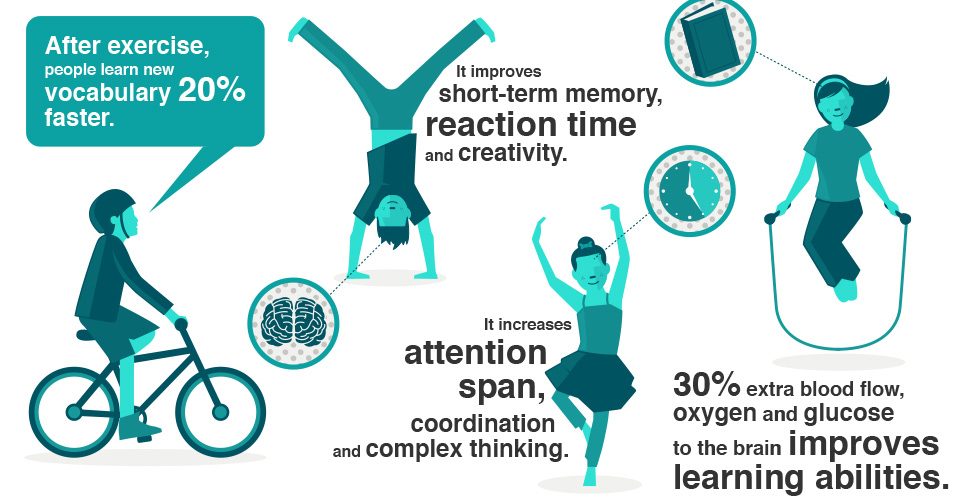Learning is a lifelong process and the sources of learning are never confined to the academic sphere. An individual can learn from literally anything and everything that is around. The main purpose of learning, as propounded by renowned educationists and philosophers is the holistic development of an individual that includes his or her physical, cognitive, emotional and social development.
When it comes to learning in educational institutions such as schools and colleges, the learners are defined with regard to proper age groups. Schools lay down the initial foundation of the preparatory stage of a child’s life. On entering adolescence, the learner becomes more matured and hence gets more interested in the process of learning. In this regard, it should be mentioned that the children who have the habit of carrying out physical exercises as a regular part of the everyday routine are more active learners than those who prefer to sit quietly and learn.
How Does Physical Exercise Contribute to Enhancing the Process of Learning?
Physical exercise can stimulate the process of learning to a great percentage. The following points describe how it actually works:
Serves to Improve Verbal Learning and Memory: A scientific study has proven that when a child is regularly involved in aerobic exercises which cause physical exertion by pumping the sweat glands, the activity of the hippocampus in the brain gets boosted. This particular area of the brain helps us to retain memories and improves capacities of verbal learning. However, the outcomes are somewhat different when a child learns resistance training, muscle toning, and body balancing exercises.
Helps in Controlling Moods: Physical exercises lead to the relaxation of muscles and helps a child to have a good sleep which is very much necessary in the present day hectic scenario. It also reduces anxiety and tension, and all these automatically prevent mood swings which are regular occurrences among children. Once your child’s mind becomes calm and composed, he or she will automatically be able to concentrate better on studies.
Enhances Creativity Level: It has been shown by eminent scholars that the creativity level of an individual is enhanced through walking. This walking can be done either on a treadmill or in a green lawn. It generates the process of divergent thinking and helps to generate new ideas and creative thoughts. Also, the rate of cognitive decline can be slowed down through brisk walking of about 30-45 minutes per day.
Helps in Stress Management: One of the most effective benefits of physical exercise can be seen in the ways it helps to manage stress. Once a child is out from all the burdens that are imposed on him or her, better functioning, particularly in case of learning, can be easily expected. The ability to concentrate can be enhanced once a person is out of stress and is in a relaxed state of mind. For this, exercises such as yoga and pranayama have been proven to be effective means.
Other Health Benefits: Studies have revealed that at least 30 minutes of exercise can help keep the insulin level of the child in check and can release the chemicals in the brain cells that affect cognitive development. It helps strengthen the blood vessels of the brain and improves the survival and abundance of new blood cells, which help keep a child away from threatening diseases. Any sort if inflammation in the brain is also reduced with the help of physical exercises.
Thus, by analyzing all the aforementioned connections between learning and physical exercises, it can be well understood that a child shall be able to become a more effective learner if he or she is involved in regular physical exercises from the very beginning. However, it should be remembered that this time is not the right one to hit the gym. It is better to involve children in other forms of exercises such as regular walking, jogging, and yoga. For yoga and aerobics, it is always better to take the help of an experienced professional trainer as if these are taught in a wrong way, several health hazards can be created.
We, at the K.R. Mangalam School, are very well aware of the benefits that physical exercise has on the well-being of an individual, and this is why we always ensure that each and every student of ours do devote at least some time to physical fitness at school itself, by making them participate in sports or other such activities. Physical training helps children become more physically active. Since the brain cannot function in isolation, it needs active cooperation from other organs of the body as well, which eventually helps in keeping the individual running and actively learning. We, at KRMU, would also like to urge the parents to understand the importance of physical exercises in the life of their children and act accordingly by taking necessary steps. Since children today are more prone to technology and gadgets, it is necessary that parents and guardians make it a point to ask children to make controlled use of these and keep themselves active in physical activities in order to become healthy and responsible citizens of the future.




Leave a Reply